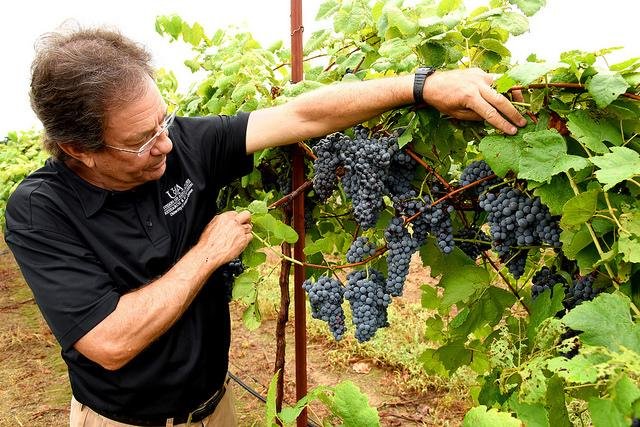The Arkansas wine industry has a new edge -- two grapes designed to thrive in the state's challenging climate.
The breeding program at the University of Arkansas System's Agriculture Division has released a new white grape called Opportunity and a new red grape called Enchantment. Fruit breeder John Clark, a professor of horticulture at the Agriculture Division, has been working on the grapes for more than 20 years.
"This is a very difficult environment to grow fruit," Clark said. "We have cold winters and hot summers."
Arkansas grapes also have to battle diseases incubated in the humidity. The average annual yield in Arkansas is about 3 tons of grapes per planted acre, according to a 2012 study by Frank Rimerman & Co., a California accounting firm, funded by Arkansas Tech University. The study blames the harsh climate for low yields. California vineyards produced about 9.4 tons per acre in 2013.
"If Arkansas is to gain traction and continue producing enough wine in the state to meet consumer demand, the industry will need to improve yields going forward," the study said.
The Arkansas wine industry has grown since Clark and mentors, including the l̶a̶t̶e retired Jim Moore who started the Arkansas breeding program, and the r̶e̶t̶i̶r̶e̶d late Justin Morris*, started working to improve the quality of Arkansas-grown grapes.
Wine, grapes and other related industries employed about 1,700 Arkansans with a payroll of $42 million in 2010, according to the study commissioned by Arkansas Tech.
Wineries in Arkansas accounted for 78 full-time positions in 2010, according to the same survey, leading to a payroll of about $3.6 million. The state wine industry generated $23.7 million in federal, state and local tax revenue in 2010.
Agritourism is a big revenue source for the state's wineries. The same study found that 306,000 people visited Arkansas wineries that year, generating $21 million in revenue. The study estimated the total economic impact on the state at about $173 million.
But there's room for a lot of growth. Arkansas hasn't seen the same growth in the wine industry as nearby states. A more recent but similar study in neighboring Missouri, which has a similar climate, estimated the total economic impact from the industry on the state at $1.76 billion in 2013.
Developing wine grapes can take a long time, Clark said. Unlike table grapes or other fruit, the grape has to be processed into wine before researchers can judge its quality.
"We had more than 100 [grape] selections at one time," Clark said. "We whittled them down to three or four."
Post Familie Winery in Altus has been helping researchers select and turn the grapes into wine throughout the research process, which has been going for about the past decade, said Renee Threlfall, a research scientist at the University of Arkansas Institute of Food Science and Engineering.
Only small quantities of wine from the new grapes have been made, but the research team hopes the amount will grow as the grapes are selected for more vineyards.
The researchers select for desirable characteristics, including smell, color and taste. Threlfall said the team got input from the Arkansas wine industry before narrowing the best grapes to Opportunity and Enchantment.
Some grapes are grown easily in Arkansas, but they don't make fine wine, Clark said. To develop a new Arkansas wine grape, the researchers bred American wild grapes that thrive in the state with European varieties.
"The more of the American grape, the poorer the quality of wine," Clark said.
Now, the grapes have been released to UA's Agriculture Division, and cuttings are available to commercial growers in Arkansas and any other areas with a similar climate.
"Vineyards can try and get the vines, but we don't know if they will be excited by it," he said. "It could easily be four to five years before the wine is on the market."
SundayMonday Business on 11/20/2016
*CORRECTION: An earlier version of this story incorrectly identified Jim Moore and Justin Morris.

